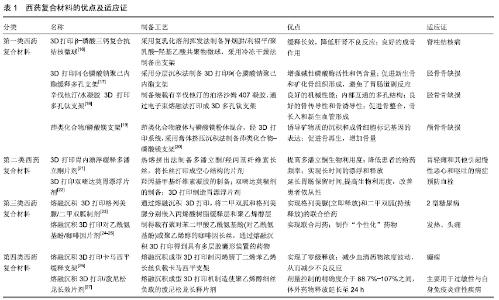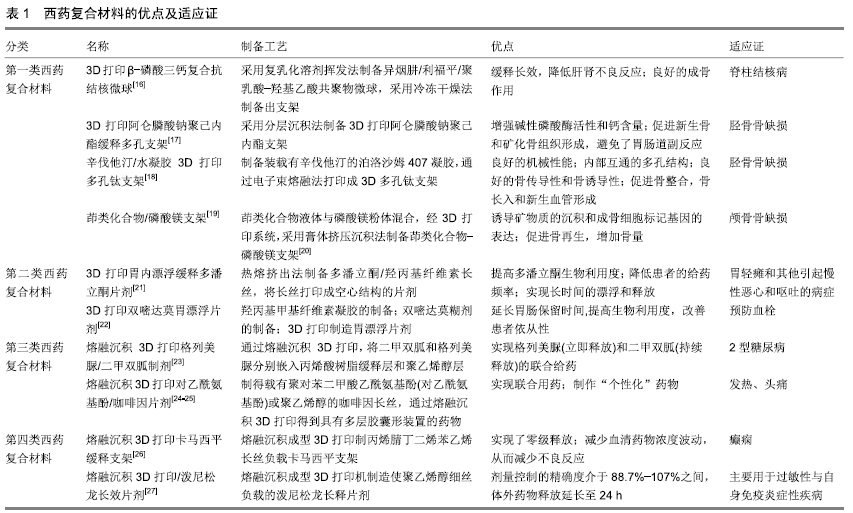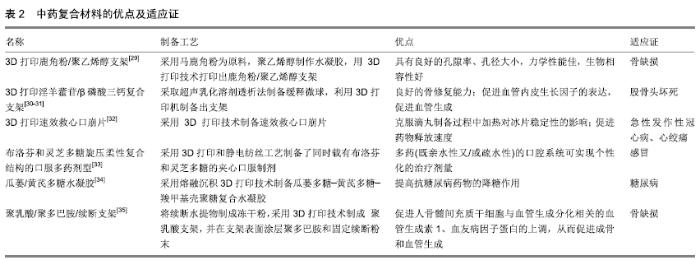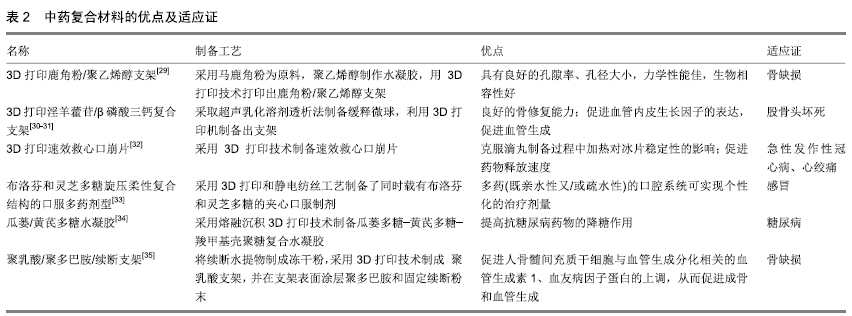Chinese Journal of Tissue Engineering Research ›› 2020, Vol. 24 ›› Issue (10): 1629-1633.doi: 10.3969/j.issn.2095-4344.1924
Previous Articles Next Articles
Application of 3D-printed drug composite material in biomedicine
Hou Jingxia1,2, Wang Dan1,2, Wei Chenxu1,2, Lin Shangyang1,2, Chen Zhipeng1,2, Li Weidong1,2
- 1School of Pharmacy, Nanjing University of Chinese Medicine, Nanjing 210023, Jiangsu Province, China; 2Jiangsu Provincial Key Laboratory of Traditional Chinese Medicine Processing, Nanjing 210023, Jiangsu Province, China
-
Received:2019-05-20Revised:2019-05-27Accepted:2019-06-27Online:2020-04-08Published:2020-02-18 -
Contact:Li Weidong, Researcher, School of Pharmacy, Nanjing University of Chinese Medicine, Nanjing 210023, Jiangsu Province, China; Jiangsu Provincial Key Laboratory of Traditional Chinese Medicine Processing, Nanjing 210023, Jiangsu Province, China -
About author:Hou Jingxia, Master candidate, School of Pharmacy, Nanjing University of Chinese Medicine, Nanjing 210023, Jiangsu Province, China; Jiangsu Provincial Key Laboratory of Traditional Chinese Medicine Processing, Nanjing 210023, Jiangsu Province, China -
Supported by:the National Natural Science Foundation of China, No. 81373970; Jiangsu Postgraduate Practice Innovation Program, No. SJCX19_0414
CLC Number:
Cite this article
Hou Jingxia, Wang Dan, Wei Chenxu, Lin Shangyang, Chen Zhipeng, Li Weidong. Application of 3D-printed drug composite material in biomedicine[J]. Chinese Journal of Tissue Engineering Research, 2020, 24(10): 1629-1633.
share this article

2.1 西药复合材料 西药具有化学成分明确、药理作用清晰、见效快等优点,但部分药物也存在一些弊端,比如生物利用度低、毒副作用大、不能实现个性化给药等。将西药与具有良好生物相容性的材料相结合制成具有一定治疗作用的支架或其他剂型,统称为西药复合材料。按适应证主要分为4类:①第一类是治疗骨缺损的西药复合材料:如将一线抗结核药物异烟肼、利福平以传统应用形式用于骨结核病灶区时,由于药物缺乏载体易被液体稀释或冲走,达不到有效的抑菌浓度,而且肝肾不良反应大,将其做成复合材料可避免此缺点;②第二类是3D打印胃内漂浮片剂:与传统剂型相比,胃滞留药物递送系统延长了胃滞留时间,带来了显著益处,包括延长药物保留时间、明确药物持续释放曲线、具有恒定的血浆药物浓度、增加患者依从性、提高药物生物利用度等。适用于在胃肠道或肠液中不稳定,或在肠道中溶解性差的药物。实现胃滞留的方法主要包括胃内漂 浮[11]、肿胀和扩张[12]、黏膜粘连[13]、低密度系统[14]。胃内漂浮药物递送系统可以在药物到达其吸收部位之前连续释放药物来改善具有吸收问题的药物受控递送,从而确保其最佳生物利用度[15];③第三类是实现联合用药的西药复合材料:联合药物治疗常用于治疗癌症、糖尿病、心血管疾病和感染等疾病,并且在许多情况下药物以相同的剂型组合,以方便服用和改善患者依从性;④第四类是其他西药复合材料:主要介绍了将卡马西平和泼尼松龙运用熔融沉积3D打印方法制成了支架和片剂,减少了药物不良反应及对药物剂量进行了精确控制,对于癫痫及自身免疫性炎症疾病有很好的效果。4类西药复合材料具体制备工艺、优点及适应证详见表1。 "


2.2 中药复合材料 中药复合材料主要介绍的是将具有药物活性的中药粉末或其提取物单体、有效部位与具有良好生物相容性的骨修复材料结合制成支架,用于骨缺损的治疗,或通过3D打印技术制成某种剂型,提高药物在体内释放速率。主要介绍的药物有鹿角粉、淫羊藿苷、速效救心丸、灵芝多糖、瓜蒌及黄芪多糖、续断。其中速效救心丸、灵芝多糖、瓜蒌及黄芪多糖、续断。其中马鹿角中含有大量的无机元素,尤以Ca、P含量较高,而Ca是生命活动中的重要元素,也是骨代谢的重要因 子[28]。淫羊藿苷是一种良好的骨诱导活性因子,在促进成骨细胞增殖的同时能抑制破骨细胞分化并促进血管生成,但其难溶于水、生物利用度低。速效救心丸是目前临床上治疗冠心病、心绞痛的良方,被药典所收载。灵芝多糖是灵芝中主要有效成分,具有多种药理活性,与布洛芬合用可用于治疗感冒并提高患者的免疫力。瓜蒌及黄芪多糖与抗糖尿病药具有协同降糖作用。续断是中药骨伤科之要药。各中药药物复合材料的制备工艺、优点及适应证详见表2。 "

| [1] LI Q, GUAN X, CUI M,et al. Preparation and investigation of novel gastro floating tablets with 3D extrusion-based printing.Int J Pharm. 2018;535(1-2):325-332. [2] 刘长青,王海霞,李正,等.3D打印技术在中药创新研制与应用方面的研究进展[J].中国实验方剂学杂志, 2019, https://doi.org/10.13422/j.cnki.syfjx.20191947 [3] 易超然,罗婕姝,王文军,等.3D打印技术在骨组织修复个体化治疗中的应用进展[J].中南医学科学杂志,2015,43(3):330-333. [4] 秦勉,刘亚雄,贺健康,等.数字化设计3D打印技术在个性化医疗中应用[J].中国修复重建外科杂志,2014,28(3):286-291. [5] GOYANES A, MARTINEZ PR, BUANZ A, et al.Effect of geometry on drug release from 3D printed tablets.Int J Pharm.2015;494(2): 657-663. [6] ZHANG J, FENG X, PATIL H, et al.Coupling 3D printing with hot-melt extrusion to produce controlled-release tablets.Int J Pharm. 2017;519(1-2):186-197. [7] BOETKER J, WATER JJ, AHO J, et al.Modifying release characteristics from 3D printed drug-eluting products.Eur J Pharm Sci.2016;90:47-52. [8] BECK RCR, CHAVES PS, GOYANES A, et al.3D printed tablets loaded with polymeric nanocapsules: an innovative approach to produce customized drug delivery systems.Int J Pharm.2017; 528(1-2):268-279. [9] BOSE S, BANERJEE D, BANDYOPADHYAY A.Introduction to Biomaterials and Devicesfor Bone Disorders. Mater Bone Dis. 2017: 1-27. [10] ZHANG M, RAMAY H. U.S. Patent Application No.10/846,356, 2005. [11] PATEL A,MODASIYA M,SHAH D,et al.Development andIn Vivo Floating Behavior of Verapamil HCl Intragastric Floating Tablets. AAPS Pharm Sci Tech.2009;10(1):310. [12] KLAUSNER EA, LAVY E, FRIEDMAN M, et al. Expandable gastroretentive dosage forms. J Controlled Release.2003; 90(2): 143-162. [13] CHAVANPATIL MD, JAIN P, CHAUDHARI S, et al.Novel sustained release, swellable and bioadhesive gastroretentive drug delivery system for ofloxacin.Int J Pharm.2006;316(1):86-92. [14] LI Z, XU H, LI S, et al. A novel gastro-floating multiparticulate system for dipyridamole (DIP) based on a porous and low-density matrix core: In vitro and in vivo evaluation.Int J Pharm.2014; 461(1-2): 540-548. [15] BANSAL AK. Gastric-retention: a means to address regional variability in intestinal drug absorption (Drug Delivery).Pharma Techno.2003:1-20. [16] 叶铄.β磷酸三钙复合抗结核微球的体外、体内释药研究[D].兰州:甘肃中医药大学,2015. [17] KIM SE, YUN YP, SHIM KS, et al.3D printed alendronate- releasing poly (caprolactone) porous scaffolds enhance osteogenic differentiation and bone formation in rat tibial defects. Biomed Mater.2016;11(5):055005. [18] LIU H, LI W, LIU C, et al.Incorporating simvastatin/poloxamer 407 hydrogel into 3D-printed porous Ti6Al4Vscaffolds for the promotion of angiogenesis, osseointe-gration and bone ingrowth. Biofabrication. 2016;8(4):045012. [19] LEE J, FARAG MM, PARK EK, et al.A simultaneous process of 3D magnesium phosphate scaffold fabrication and bioactive substance loading for hard tissue regeneration.Mater Sci Eng C Mater Biol Appl. 2014;36(1):252-260. [20] LEE J, FARAG MM, PARK EK, et al.A simultaneous process of 3D magnesium phosphate scaffold fabrication and bioactive substance loading for hard tissue regeneration.Mater Sci Eng C Mater Biol Appl. 2014;36(1):252-260. [21] CHAI X, CHAI H, WANG X, et al.Fused Deposition Modeling (FDM) 3D Printed Tablets for Intragastric Floating Delivery of Domperidone. Sci Rep. 2017;7(1):2829. [22] LI Q, GUAN X, CUI M, et al. Preparation and investigation of novel gastro-floating tablets with 3D extrusion-based printing. Int J Pharm. 2018;535(1-2):325-332. [23] GIOUMOUXOUZIS CI, BAKLAVARIDIS A, KATSAMENIS OL, et al. A 3D printed bilayer oral solid dosage form combining metformin for prolonged and glimepiride for immediate drug delivery.Eur J Pharm Sci. 2018;120:40-52. [24] DERRY CJ, DERRY S, MOORE RA.Caffeine as an analgesic adjuvant for acute pain in adults.J Pain Pall Care Pharm.2012; 26(3):282-282. [25] GOYANES A, WANG J, BUANZ A, et al.3D Printing of Medicines: Engineering Novel Oral Deviceswith Unique Design and Drug Release Characteristics.Mol Pharmaceut.2015;12(11):4077-4084. [26] LIM SH, CHIA SMY, KANG L, et al.Three-Dimensional Printing of Carbamazepine Sustained-Release Scaffold.J Pharm Sci. 2016; 105(7): 2155. [27] SKOWYRA J, PIETRZAK K, ALHNAN MA.Fabrication of extended- release patient-tailored prednisolone tablets via fused deposition modelling (FDM) 3D printing.Eur J Pharm Sci.2015; 68:11-17. [28] KINNEAR C, BURNAND D, CLIFT MJ, et al.Polyvinyl alcohol as a biocompatible alternative for the passivation of gold nanorods. Angew Chem Int Ed Engl. 2014;53(46):12613-12617. [29] 赵小琦,丁刘闯,韩祥祯,等.3D打印鹿角粉/聚乙烯醇支架与纳米级羟基磷灰石/聚乙烯醇支架的性能比较[J].口腔医学研究,2018,34(9): 1011-1015. [30] 薛鹏. 3D打印淫羊藿苷-β-磷酸三钙复合材料对兔股骨头坏死骨修复的实验研究[D].南京:南京中医药大学,2018. [31] 缪丹丹,张超,孙洪范.淫羊藿苷纳米粒的制备及其对人成骨细胞的影响[J].国际生物医学工程杂志,2015,38(5):282-286,305. [32] 林启凤,杨帆,范凯燕,等.3D打印速效救心口崩片的制备研究[J].广东药学院学报,2016,32(1):1-4. [33] WU ST, LI JS, MAI J, et al. 3D electrohydrodynamic printing and spinning of flexible composite structures for oral multi-drug forms.ACS Appl Mater Inter.2018;10(29):24876-24885. [34] YAN JX, WANG Y, ZHANG X, et al.Snakegourd root/Astragalus polysaccharide hydrogel preparation and application in 3D printing. Int J Biol Macromol.2019;121:309-316. [35] YEH CH, CHEN YW, SHIE MY, et al.Poly(dopamine)-assisted immobilization of Xu Duan on 3D printed poly (lactic acid) scaffolds to up-regulate osteogenic and angiogenic markers of bone marrow stem cells.Materials(Basel).2015;8(7):4299-4315. [36] ZHENG Y, GU X, WITTE F. Biodegradable metals.Mater Sci Engineer R Rep. 2014;77:1-34. [37] HE LY, ZHANG XM, LIU B, et al.Effect of magnesium ion on human osteoblast activity. Braz J Med Biol Res.2016;49(7):e5257. [38] YOSHIZAWA S, BROWN A, BARCHOWSKY A, et al.Role of magnesium ions on response in bone marrow stromal cells. Connect Tissue Res. 2014;55(S1):155-159. [39] YOSHIZAWA S, BROWN A, BARCHOWSKY A, et al.Magnesium ion stimulation of bone marrow stromal cells enhances osteogenic activity, simulating the effect of magnesium alloy degradation. Acta Biomaterialia. 2014;10(6):2834-2842. [40] LAWS DR, CHONG DS, NASH K, et al.Synthesis and characterization of tricalcium phosphate with Zn and Mg based dopants.Mater Sci Mater Med.2008;19(7):2669-2677. [41] 李烨.具有促成骨活性的PLGA/TCP/Mg复合多孔支架修复骨缺损研究[D].深圳:中国科学院深圳先进技术研究院,2016. [42] HONG D, CHOU DT, VELIKOKHATNYI OI, et al.Binder-jetting 3D printing and alloy development of new biodegradable Fe-Mn-Ca/Mg alloys. Acta Biomater.2016;45:375-386. [43] PRICE CT, KOVAL KJ, LANGFORD JR. Silicon: A Review of Its Potential Role in the Prevention and Treatment of Postmenopausal Osteoporosis. Int J Endocrinol.2013;2013:1-6. [44] BOSE S, BANERJEE D, ROBERTSON S, et al.Enhanced In Vivo Bone and Blood Vessel Formation by Iron Oxide and Silica Doped 3D Printed Tricalcium Phosphate Scaffolds. Ann Biomed Eng. 2018; 46(9): 1241-1253. [45] TARAFDER S, DERNELL WS, BANDYOPADHYAY A, et al.SrO- and MgO- doped microwave sintered 3D printed tricalcium phosphate scaffolds: Mechanical properties and in vivo osteogenesis in a rabbit model. J Biomed Mater Res B Appl Biomater.2015;103(3): 679-690. [46] YUAN W, HE X, ZHOU X, et al.Hydroxyapatite Nanoparticle- Coated 3D-Printed Porous Ti6Al4V and CoCrMo Alloy Scaffolds and Their Biocompatibility to Human Osteoblasts. J Nanosci Nanotechnol. 2018;18(6):4360-4365. |
| [1] | Lu Dezhi, Mei Zhao, Li Xianglei, Wang Caiping, Sun Xin, Wang Xiaowen, Wang Jinwu. Digital design and effect evaluation of three-dimensional printing scoliosis orthosis [J]. Chinese Journal of Tissue Engineering Research, 2021, 25(9): 1329-1334. |
| [2] | Zhang Tongtong, Wang Zhonghua, Wen Jie, Song Yuxin, Liu Lin. Application of three-dimensional printing model in surgical resection and reconstruction of cervical tumor [J]. Chinese Journal of Tissue Engineering Research, 2021, 25(9): 1335-1339. |
| [3] | Zhang Chao, Lü Xin. Heterotopic ossification after acetabular fracture fixation: risk factors, prevention and treatment progress [J]. Chinese Journal of Tissue Engineering Research, 2021, 25(9): 1434-1439. |
| [4] | Jiao Hui, Zhang Yining, Song Yuqing, Lin Yu, Wang Xiuli. Advances in research and application of breast cancer organoids [J]. Chinese Journal of Tissue Engineering Research, 2021, 25(7): 1122-1128. |
| [5] | Zeng Yanhua, Hao Yanlei. In vitro culture and purification of Schwann cells: a systematic review [J]. Chinese Journal of Tissue Engineering Research, 2021, 25(7): 1135-1141. |
| [6] | Liu Zhengpeng, Wang Yahui, Zhang Yilong, Ming Ying, Sun Zhijie, Sun He. Application of 3D printed interbody fusion cage for cervical spondylosis of spinal cord type: half-year follow-up of recovery of cervical curvature and intervertebral height [J]. Chinese Journal of Tissue Engineering Research, 2021, 25(6): 849-853. |
| [7] | Xu Junma, Yu Yuechao, Liu Zhi, Liu Yu, Wang Feitong. Application of 3D-printed coplanar template combined with fixed needle technique in percutaneous accurate biopsy of small pulmonary nodules [J]. Chinese Journal of Tissue Engineering Research, 2021, 25(5): 761-764. |
| [8] | Xu Dongzi, Zhang Ting, Ouyang Zhaolian. The global competitive situation of cardiac tissue engineering based on patent analysis [J]. Chinese Journal of Tissue Engineering Research, 2021, 25(5): 807-812. |
| [9] | Liu Yang, Gong Yi, Fan Wei. Anti-hepatoma activity of targeted Pluronic F127/formononetin nanocomposite system in vitro [J]. Chinese Journal of Tissue Engineering Research, 2021, 25(4): 526-531. |
| [10] | Wu Zijian, Hu Zhaoduan, Xie Youqiong, Wang Feng, Li Jia, Li Bocun, Cai Guowei, Peng Rui. Three-dimensional printing technology and bone tissue engineering research: literature metrology and visual analysis of research hotspots [J]. Chinese Journal of Tissue Engineering Research, 2021, 25(4): 564-569. |
| [11] | Chang Wenliao, Zhao Jie, Sun Xiaoliang, Wang Kun, Wu Guofeng, Zhou Jian, Li Shuxiang, Sun Han. Material selection, theoretical design and biomimetic function of artificial periosteum [J]. Chinese Journal of Tissue Engineering Research, 2021, 25(4): 600-606. |
| [12] | Liu Fei, Cui Yutao, Liu He. Advantages and problems of local antibiotic delivery system in the treatment of osteomyelitis [J]. Chinese Journal of Tissue Engineering Research, 2021, 25(4): 614-620. |
| [13] | Li Xiaozhuang, Duan Hao, Wang Weizhou, Tang Zhihong, Wang Yanghao, He Fei. Application of bone tissue engineering materials in the treatment of bone defect diseases in vivo [J]. Chinese Journal of Tissue Engineering Research, 2021, 25(4): 626-631. |
| [14] | Zhang Zhenkun, Li Zhe, Li Ya, Wang Yingying, Wang Yaping, Zhou Xinkui, Ma Shanshan, Guan Fangxia. Application of alginate based hydrogels/dressings in wound healing: sustained, dynamic and sequential release [J]. Chinese Journal of Tissue Engineering Research, 2021, 25(4): 638-643. |
| [15] | Chen Jiana, Qiu Yanling, Nie Minhai, Liu Xuqian. Tissue engineering scaffolds in repairing oral and maxillofacial soft tissue defects [J]. Chinese Journal of Tissue Engineering Research, 2021, 25(4): 644-650. |
| Viewed | ||||||
|
Full text |
|
|||||
|
Abstract |
|
|||||

